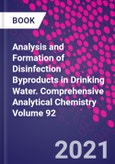Drinking water disinfection has markedly reduced diseases causes by waterborne pathogenic microorganisms. However, an unintended consequence of disinfection and/or oxidation processes is the generation of disinfection byproducts (DBPs) which are formed from the reactions of disinfectants/oxidants with water matrix components. This volume of the Comprehensive Analytical Chemistry Handbook presents recent advances about the formation, identification, and quantification of inorganic and organic DBPs during oxidative processes. The book begins with a first chapter reviewing the most recent non-targeted screening approaches and workflows to characterize DBPs using low-, high-, and ultra-high-resolution mass spectrometry. The second chapter discusses the analysis of inorganic chloramines in waters using on-site and/or in-lab analytical methods. The third chapter provides an overview of the current knowledge about the mechanisms of chlorine dioxide reactions and byproducts formation. The fourth chapter presents some fundamental and practical aspects about ozonation processes in water treatment and provides an overview about ozone reaction mechanisms and byproducts formation. The fifth chapter focuses on the reactivity of halide ions, particularly bromide and iodide, with common oxidants and the role they play in determining the speciation of DBPs in treated waters. The chapter also presents strategies to mitigate the formation of DBPs during oxidation processes. Finally, the last chapter tackles the topic of DBPs formation during potable water reuse. It discusses the formation of DBPs of major concern in both memebrane-based and non-membrane-based potable water reuse treatment schemes.
Researchers, water treatment specialists, and regulators will find in this book a valuable and compact resource on several key topics regarding the formation, identification, quantification, and mitigation of DBPs.
Please Note: This is an On Demand product, delivery may take up to 11 working days after payment has been received.
Table of Contents
1. Non-target screening and novel methods based on mass spectrometry detection for identification of unknown disinfection byproductsCristina Postigo and Susan D. Richardson
2. Inorganic chloramines analysis in water
Jean-Luc Boudenne, Fabien Robert-Peillard and Bruno Coulomb
3. Mechanisms and byproduct formation in the application of chlorine dioxide
Mohammad Sajjad Abdighahroudi, Mischa J�tte, Katharina Hupperich, Xenia Mutke, Torsten C. Schmidt and Holger V. Lutze
4. Ozonation in drinking water treatment: An overview of general and practical aspects, mechanisms, kinetics, and byproduct formation
Tarek Manasfi
5. Influence of bromide and iodide on the formation of disinfection by-products in drinking water treatment
Justine Criquet and S�bastien Allard
6. Disinfection byproducts in potable reuse
Maria Jos� Farr� and Wolfgang Gernjak








